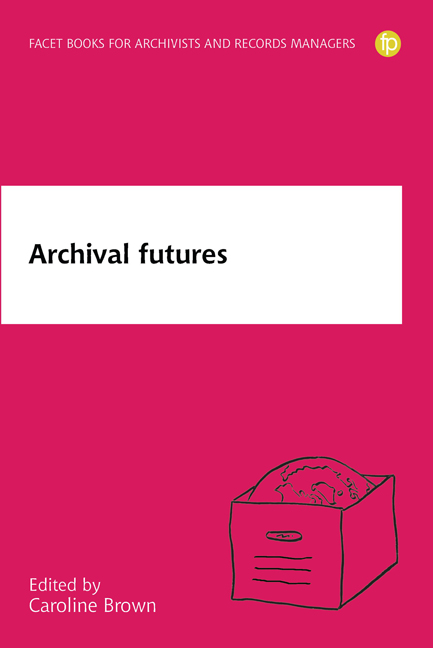Book contents
- Frontmatter
- Dedication
- Contents
- Notes on contributors
- Introduction
- 1 It's the end of the archival profession as we know it, and I feel fine
- 2 Whose truth? Records and archives as evidence in the era of post-truth and disinformation
- 3 The future of archives as networked, decentralised, autonomous and global
- 4 Can we keep everything? The future of appraisal in a world of digital profusion
- 5 Frames and the future of archival processing
- 6 Access technologies for the disruptive digital archive
- 7 Multiple rights in records: the role of recordkeeping informatics
- 8 The accidental archive
- 9 The end of archival ideas?
- Index
5 - Frames and the future of archival processing
Published online by Cambridge University Press: 01 June 2019
- Frontmatter
- Dedication
- Contents
- Notes on contributors
- Introduction
- 1 It's the end of the archival profession as we know it, and I feel fine
- 2 Whose truth? Records and archives as evidence in the era of post-truth and disinformation
- 3 The future of archives as networked, decentralised, autonomous and global
- 4 Can we keep everything? The future of appraisal in a world of digital profusion
- 5 Frames and the future of archival processing
- 6 Access technologies for the disruptive digital archive
- 7 Multiple rights in records: the role of recordkeeping informatics
- 8 The accidental archive
- 9 The end of archival ideas?
- Index
Summary
Introduction
In 1989, David Bearman published an essay entitled ‘Archival Methods’ in which he set out a comparison between the magnitude of the tasks archivists had set themselves and the magnitude of their capabilities, revealing ‘substantial discrepancies’ (Bearman, 1989). Revisiting this work in 1995, he noted that: ‘No one has directly disputed the claim that our methods are out of sync with the problems by more than an order of magnitude’ (Bearman, 1995, 381–2). Indeed, in 2005, a very similar claim was made by Mark Greene and Dennis Meissner who stated that: ‘Processing backlogs continue to be a problem for archivists, and yet the problem is exacerbated by many of the traditional approaches to processing collections that archivists continue to practice’ (Greene and Meissner, 2005, 208). They too, as Bearman had done, called for archivists to think again about their methods and made suggestions for new approaches.
The suggestion, in 1989, 1995 and 2005, was that traditional archival methods were inadequate; they could not hope to succeed given the scale of the task at hand and needed to change. It is now over 12 years later and yet it would be very easy for this chapter to become just another instance of the same: a stark reminder of the ever-increasing magnitude and difficulty of the archival task, a call to rethink and some suggestions for how to proceed. In striving to avoid this easy path, this chapter will instead seek to cover the ground from a slightly different angle by exploring some of the solutions that have been proposed by others and using them as a starting point for a discussion about the future of archival processing.
In the above, the terms archival methods and archival processing have been used interchangeably and there is a broad sense in which both can be taken to mean all the things that archivists do: their activities, their processes, their methods. Archivists undertake many different processes, however, and the Society of American Archivists’ glossary narrows its definition of processing down to the ‘arrange - ment, description, and housing of archival materials for storage and use by patrons’, although it also notes that ‘Some archives include accessioning as part of processing’ (Society of American Archivists, n.d.).
- Type
- Chapter
- Information
- Archival Futures , pp. 65 - 78Publisher: FacetPrint publication year: 2018
- 2
- Cited by

